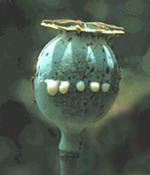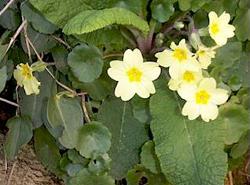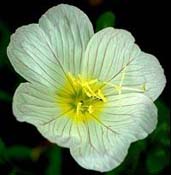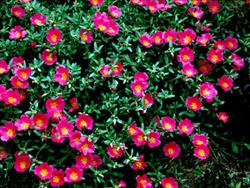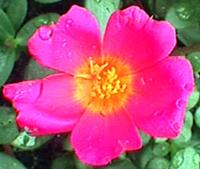



**WC** This is one herb, that unless you live in Indonesia or the Pacific Islands, you won't be gathering wild. I am eagerly awaiting Daemonorops Draco seed from a friend that lives in Hawaii and has some growing. **GT** Besides being extremely hard to find in the continental U.S., Draco is also very hard to grow due to its demanding climatic requirements. I live in South Florida on Tampa Bay so we have a climate here very similiar to its native area. Update: March/2000-The seeds arrived and have sprouted beautifully...I am so excited! Wouldn't it be great to get this plant established in the U.S. so we could get the prices down on Dragon's Blood? (Not to mention keeping the funds spent on it IN the United States...)
**Update: 2/14/01 The plants are very slow growers but healthy. Eight inches in one year...kudzu it ain't! *wink*
Parsley-
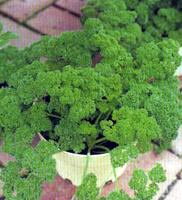
Parsley's (Carum Petroselinum and Petroselinum Crispum) name comes from the Greek "Petros" which means "mountain", and "Selinon" which is the word for the celery family. In "A Modern Herbal" Grieve states: "..petroselinum, signifying 'Rock selinon.' This last name in the Middle Ages became corrupted into Petrocilium - this was anglicized into Petersylinge, Persele, Persely and finally Parsley. There is an old superstition against transplanting parsley plants. The herb is said to have been dedicated to Persephone and to funeral rites by the Greeks. The Greeks held Parsley in high esteem, crowning the victors with chaplets of Parsley at the Isthmian games, and making with it wreaths for adorning the tombs of their dead. The herb was never brought to table of old, being held sacred to oblivion and to the dead. It was reputed to have sprung from the blood of a Greek hero, Archemorus, the forerunner of death, and Homer relates that chariot horses were fed by warriors with the leaves". The English to this day say that Parsley seed goes "seven times to the Devil and back before it germinates" (it does seem to take forever) and claim that only witches can grow it...laughing quietly to myself...
Magickal Uses:
Parsley is a funeral herb ruled by Mercury and Mars. Its invocatory can be Aphrodite, Persephone, or Venus. Parsley has strong associations with the Otherworld. Parsley was sacred to Persephone, wife of Hades and Goddess of the Underworld. In "A Modern Herbal" Grieve relates that "Parsley was afterwards consecrated to Saint Peter in his character of successor to Charon." Charon, as the ferryman across the river Styx, collects a fee from those being transported to the Underworld. This creates an interesting characterization of the Christian Saint Peter! Sacred to Venus and Aphrodite, Parsley used for success and romance should be gathered on a Friday beneath a waxing Moon. Parsley is recommended for baby blessings. When used as a bathing herb, Parsley brings communion with the second aspect of the Goddess, that of the loving mother of the Universe. This procedure is highly recommended when a priestess intends to invoke this form of the Goddess or for a woman whois with child and desires a healthy pregnancy. Parsley continues to have value in rituals of death and dying, and it is a good herb to plant at burial sites.
Medicinal and Other Uses:
Parsley is traditionally a curative, a property captured by Beatrix Potter in "The Tale of Peter Rabbit", when she says about the naughty rabbit: "First he ate some lettuce and some broad beans, then some radishes, and then, feeling rather sick, he went to look for some parsley." Parsley is a rich source of Iron, beta carotene and Vitamins B1, B2 and C. As a medicinal plant, Parsley has traditionally been used as an antispasmodic, carminative, diuretic, emmenagogue, and stomachic. The plant has also been used as a remedy for asthma, conjunctivitis, dropsy, fever, and jaundice. The essential oil of Parsley seed has been reported to stimulate hepatic regeneration. The seeds, leaves, and essential oils of Parsley are utilized as condiments or seasonings. Fresh leaves are used for garnishing such food dishes as meat, fish, and vegetables. Fresh, dried, and dehydrated leaves flavor a wide array of food products, including salads, sauces, soups, stews, eggs, and processed foods. Parsley-seed oil is employed as a fragrance in perfumes, soaps, and creams. The plant is sometimes grown as an ornamental edging plant. **GT** Petroselinum Crispum is susceptible to root rot. The seeds are slow to germinate (soak the seeds overnight prior to planting to hasten germination), and its difficult to transplant. Parsley, like Basil, is a companion of tomatoes. If you plant the two together your yields will be boosted. If you want the plants to come back and flower the second year, don't pull them up when they cease to grow.
Passion Flower-
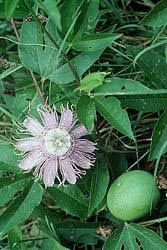
 Passion Flower (Passiflora Incarnata, also called Maypop, Apricot Vine, Maracuja, Passion Vine, and Purple Passionflower) is called "Passion-flower" because the early Spanish explorers thought there was some resemblance in the structure of the blossom to the implements of the crucifixion. Its genus, Passiflora, is the only genus of its family in the United States. The fruit is an edible leathery berry (the "May-pop"). It is the size and shape of a very large hen egg; green at first and turning yellowish as it ripens. When stomped, it makes a loud pop!! The kids in the South love this little passtime. What we in the South consider a pretty weed has become a growing commodity as of late. Passion Flower juice is a hot seller, and the fruits of the yellow variety are being sold as produce. There is a chemical compound in Passiflora that is hypnotic-sedative, and it has been making the rounds on the health food circuit as a sleeping aid.
Passion Flower (Passiflora Incarnata, also called Maypop, Apricot Vine, Maracuja, Passion Vine, and Purple Passionflower) is called "Passion-flower" because the early Spanish explorers thought there was some resemblance in the structure of the blossom to the implements of the crucifixion. Its genus, Passiflora, is the only genus of its family in the United States. The fruit is an edible leathery berry (the "May-pop"). It is the size and shape of a very large hen egg; green at first and turning yellowish as it ripens. When stomped, it makes a loud pop!! The kids in the South love this little passtime. What we in the South consider a pretty weed has become a growing commodity as of late. Passion Flower juice is a hot seller, and the fruits of the yellow variety are being sold as produce. There is a chemical compound in Passiflora that is hypnotic-sedative, and it has been making the rounds on the health food circuit as a sleeping aid.
Magickal Uses:
Passion Flower is ruled by Neptune. Passion Flower brings calm, and it may be used Magickally to promote calmness which is the result of personal transformation. It may be used as an incense to change the energy of a meeting place or as a wash for the floors or furniture if there is the potential for disagreements or stress. Passion Flower is sometimes added to ritual incense when celebrating the Autumn Equinox.
Medicinal and Other Uses:
Passion Flower is a nervine, aphrodisiac, hypnotic, anti-spasmodic, anodyne, diuretic, and hypotensive. Passiflora has a depressant effect on C.N.S. activity and is hypotensive; they are used for their sedative and soothing properties, to lower blood pressure, prevent tachycardia and for insomnia. It has been used for nerve pain such as neuralgia, for dysmenorrhea, diarrhea, and for the viral infection of nerves called shingles. It has also been used to treat urinary infections. The fruit of Passiflora is both eaten and made into juice. It is an excellent source of Niacin and a good source of Riboflavin. It is found in some anti-wrinkle cosmetics. Passionfruit has been a food staple for the people and animals of the tropical Rainforest for eons. **GT** If you live in an area where Winters are not severe, think twice about planting Passiflora where it can go wild. It has become quite a pest in some areas, and it is hard to eradicate. It grows in my woods in Georgia, and I can testify its just about impossible to get rid of. Between the Passion vines and the Kudzu I am about ready to invest in a flame thrower to save my trees!
Patchouli-

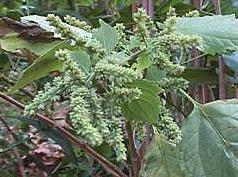
Patchouli (Pogostemon Cablin) is most famous for its oil. This is one scent that almost everyone associates with the 1960s..Free Love, Hippie Power, Sex, Drugs, Rock n' Roll. (I guess you've figured out by now I was one of those hippie chicks?) *grin* Patchouli is grown primarily in Indonesia and the Philippines...and my back yard. :o) Before distillation takes place the leaves are partially dried, stacked and bailed. This causes a slight fermentation which weakens the "oil bearing" cell walls, thus ensuring a greater yield of oil from distillation. Patchouli oil is distilled outside its growing region, using imported, cured plant material. This yields a considerably different oil that is pale orange, spicy-sweet and herbaceous. This seems to result from the recycled iron drums used by native distillers, which impart a dark brownish-red cast to the oil. You have to be very selec`tive when buying Patchouli oil, insist on smelling it first, if possible. I've opened some so called Patchouli oils that smell like pure black pepper, and that is NOT what real Patchouli oil smells like.
Magickal Uses:
Patchouli is an herb of love and an aphrodisiacal herb ruled by Pluto. This sensually scented herb is used in many aspects of lust and romance. Some use Patchouli to attract a partner, and it can be used in sachets, charms, and incense. It can be ritually used during the Great Rite as a dressing for the candles, or as a scent. I've always used Patchouli in my Mojo bag, and I add it to Money Drawing spells.
Medicinal and Other Uses:
Patchouli's dried and fermented leaves are steam distilled to extract its famous oil. Its oil is used very widely in many types of perfumes and incense. (Patchouli has served the perfume industry as a base note for many years). The warm, earthy oil of Patchouli has a history of benefiting the nervous and glandular systems for men and women. Patchouli oil has a strong earthy aroma, indicative of its value in grounding the emotional state. It stimulates the production of gastric juices and is a carminative, and it aids digestion. Some authorities mention its appetite-suppressing properties. Patchouli oil is antiseptic, anti-depressant, and a sedative. Some consider the exotic aroma is an aphrodisiac. **GT** Snails and slugs love to munch on Patchouli, so I would advise against mulching it.
Pau D'arco-

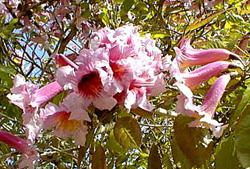
Pau D'arco (Tecoma Species, also called Trumpet Tree, Golden Rain Tree, Queshua, Tree of life, Ipe Roxo, Taheebo, Tabebuia, Lapacho, Tecoma, and Bow Stick) is a native to rainforests throughout Central and South America. Its mainly exported from Argentina, Paraguay, the West Indies, and Brazil. I am including Tabebuia Chrysotricha and Tabebuia Impetiginosa here because theres a lot of contention as to which is exactly the REAL Pau D'arco. For generations the Incas used the sap-wood of this tree for medicinal purposes. Popular reports indicate that the bark of this tree and of several other related members of Tabebuia are used in Central and South American folk medicine to make a tea that is used to treat a wide range of maladies, from arthritis to nail fungus, to ulcers to diabetes to cancer, and on and on. As a result, many herb companies and health food stores in the U.S. are vigorously promoting "lapacho teas" as a virtual cure-all. However, these compounds are also highly toxic, causing side effects such as severe nausea and anemia.
Magickal Uses:
Pau D'arco is ruled by Pluto. The energy of Pau D'arco works better during the waning Moon. This herb, so designed for healing severe disease, is well suited for ritual healing or for empowering remedies. While steeping within a cast Circle, a remedy can best be empowered by Drawing Down the Moon directly into the container of herbes. In South America it is said the Vikings, so taken with Pau D'arco's unusual color, believed it came from the Moon and traded valuable gems and jewelry for it to take it home. This myth puzzles me because, if you've ever had the pleasure of seeing a golden Pau D'arco in person, the Sun is the first planet that comes to mind.
Medicinal and Other Uses:
The main ingredient in Pau D'arco that effects medicinal cure is xyloidin (a very potent antibiotic and antiviral agent). According to the work of Prof. W. D'Acorsi and of Dr. Meyer, and other doctors and investigators, some of the conditions for which Lapacho can provide effective relief are: arteriosclerosis, arthritis, asthma, bronchitis, cystitis, diabetes, eczema, gastritis, leukaemia, Parkinson's disease, polyps (intestinal and bladder), prostate enlargement, psoriasis, pyorrhoea, rheumatism, skin and nail diseases, peptic ulcers, and varicose ulcers. Paul D'arco is an anti-fungal, antiseptic, anti-swelling agent, anti-inflammatory anti-bacterial, and anti-viral. Its used to treat chronic candidiasis, Pau D'arco is specifically used by women for diseases of the genitalia. Pau D'Arco is used with great success in cases of tumors in the uterus, and has proven to inhibit the growth of ulcers and tumors. It is a potent tonic and a blood and cell regenerator; it stimulates the natural defenses and revitalizes the body. It is also a sedative, an analgesic, and a diuretic. **GT** Down here in South Florida we have tons of Tabebuia Chrysotricha growing, its a popular street tree. They are breath taking in bloom, and one of my favorites. If you plan on planting this tree make sure its in a sheltered area (like on the side of the house that the main winter wind doesn't come from), because they are extremely prone to cold and wind damage. It will be damaged at 28 degrees F and can be frozen to the ground at lower temperatures. **WC** Pau D'arco can be highly toxic, causing side effects such as severe nausea and anemia.
Pennyroyal-

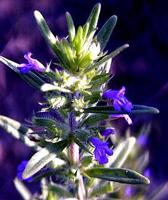
Pennyroyal (Mentha Pulegium, also known as European Pennyroyal, Run-by-the-Ground, Lurk-in-the-Ditch, Pudding Grass, and Piliolerial) is a member of the Mint family. Its named for "Minthe", a nymph in Greek Mythology who was Hades' lover. When his wife Persephone found out, in a fit of rage she turned Minthe into a lowly plant, to be trod upon. Hades could not undo the spell, but softened the spell by giving her a sweet scent which would perfume the air when her leaves were stepped upon. "Pulegium" came from the Romans, so named by Pliny from its reputed power of driving away fleas, "Pulex" being the Latin for flea. The name Pennyroyal is a corruption of the old herbalists' name "Pulioll-royall". It is said that the Greeks used Pennyroyal in the initiations of novices within the secret rituals of the Elusians.
Magickal Uses:
Pennyroyal is an herb of immortality ruled by Venus. Pennyroyal is most useful in penetrating the mysteries of death and rebirth, and is an excellent herb to use when gaining knowledge of reincarnation. Pennyroyal may be used to bath the body of the deceased prior to embalming. Its Magick helps one's spirit move in a positive direction on the path toward rebirth. Sacred to Demeter, Pennyroyal is associated with the High Priestess card of the Tarot. Its energy works well with Pearls. Albertus Magnus used Pennyroyal in conjunction with Lapis Lazuli. Folklore tells that Pennyroyal should be scattered upon stormy seas to calm them. Magickally, Pennyroyal can be used to calm many types of "stormy" situations.
Medicinal and Other Uses:
As a medicinal plant, Pennyroyal has traditionally been used as an antispasmodic, carminative, emmenagogue, sedative, stimulant, aromatic, and stomachic. It has been used to promote menstruation, cure headaches, and relieve colds. Pennyroyal Tea brewed from the leaves is often used as a diaphoretic to inducing sweating to aid in eliminating toxins from the body, and it also serves as a carminative to relieve gas, stimulate digestive action and to relieve nausea. The strong aroma of its infusion acts as a decongestant and possibly as an expectorant, helping to remove excess mucus from the lungs; it is therefore useful for coughs. The plant has been used as an insect repellent against fleas, ants, and other pests. **WC** Warning: Pennyroyal taken internally in large doses can produce convulsions and coma. (This doesn't apply to normal consumption of tea, but rather the concentrated oil). Avoid Pennyroyal if you are pregnant. The plants and oil can cause contact dermatitis.
Peony-

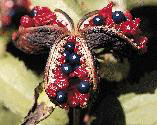
Peony (Paeonia Officinalis) is Indiana's state flower. The Peony was believed to have healing qualities and so was named after "Paeon", the physician of the Greek gods. He gave the plant its name because with Peony roots he healed Hades, god of the underworld, who had been wounded by Heracles. Few other garden plants go back in history as far as Peonies, which in China have been used and cultivated for over 4000 years. In the Middle Ages Peonies were often painted with their ripe seed-capsules, since it was the seeds, not the flowers, which were medically significant. According to historical sources, herb collectors in the Middle Ages had to take great care not to be seen by a woodpecker while digging for Peony roots, or the bird might peck out their eyes.
Magickal Uses:
Peony is an herb of protection ruled by the Sun. Its invocatory is Pan. Peony seeds are very Magickal. Harvest and dry them while sitting in the light of a Full Moon, then thread them upon a white thread and wear as a necklace to bring protection against all forms of negative energy. Peony roots are also considered powerful. The cleaned roots may be sliced, dried, and either carved into a talisman, or thread them onto a necklace. Peony is also associated with the Magick of the Moon, even though it is ruled by the Sun. In some cultures it is believed that the first Peony was a gift to humankind by the Moon Goddess, to reflect Her light and love, and guide us through the fears and darkness of night. Use Peony in conjunction with Verbena to promote Magickal healing.
Medicinal and Other Uses:
Peony is effectively applied in homeopathy for the treatment of hemorrhoids and other disorders in the anal area such as anal fissures and fhagades. In folk medicine, the roots of Paeonia are applied for gout, rheumatic disorders, as a antispasmodic, diuretuc, for sedative properties, jaundice, kidney and bladder problems, gout, menstrual cramps, asthma with cramps, epilepsy, as well as for paroxysmal pain. **GT** When selecting Peonies, be sure each tuber has three to five buds or "eyes." These will be bright red. Generally, plants will flower the second year after planting.
Periwinkle-
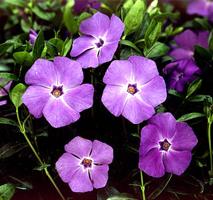
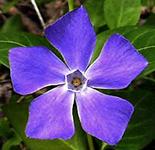
Periwinkle (Vinca Species: major & minor, also called Sorcerer's Violet, Flower of Death, Cockles, Myrtle, Pucellage, Madagascar Periwinkle, Greater & Lesser Periwinkle, and Virgin Flower) is a plant of much controvery in the medical community. It has been used in herbal folklore for eons by many native peoples, but was declared unsafe by the U.S. Food and Drug Administration. Researchers protested the agencies findings, stating it should not be included on the dangerous plants list. Immigrants brought the plant to the New World (America) to ensure a supply of this useful herb. The Vincas are best known for their anti-hemorrhaging properties. In olden times Periwinkle was said to ward off evil spirits. In France, it is called "Violette des Sorciers", or Violet of the Sorcerers. Periwinkle's name, Vinca, comes from the Latin "Vincio" meaning "to bind", an allusion to these long, trailing stems that spread over and keep down the other plants where it grows.
Magickal Uses:
Periwinkle is an herb of immortality, love, protection, purification, and a funeral herb. Few herbs are so well suited to be considered a patron herb of Wiccans. The dried flowers may be added to any mixture to enhance the Magick of the working. Periwinkle will increase the benevolence, and can be use whenever one wishes to banish negative energy. Add the dried flowers or root to love spells, amulets, sachets or charms to improve one's sense of being desirable. It is an excellent plant to offer in friendship. Periwinkle if often planted on the graves of children who were called back to the Otherworld by the Mother. It can also help in the healing of parents suffering the loss. Hang Periwinkle in the home for protection against negative energy.
Medicinal and Other Uses:
Vinca major has strong medicinal properties, and is used for migraine-like headaches, bleeding hemorroids, skin affections, and uterine bleeding. Vinca Minor has astringent qualities, is used for high blood pressure, and as a treatment for nervous disorders. **WC** As with other plants of the Dogbane family, the Vincas are poisonous, although mildly. There are also two drugs extracted from it: vinblastine (used in the treatment of Hodgkins' disease) and vincristine (used in the treatment of cancer and leukemia). Periwinkle is a powerful temporary treatment for acute short-term need, but dangerous if used regularly. Side effects: Frequent nose-bleed, pain in vertex, ringing and whistling in ears, and skin and scalp itching, hair loss, and nausea. **GT** Vinca will grow as a weed (it grows wild here), it doesn't like wet conditions, and loves a lot of sun.
Pimpernel-
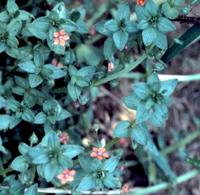

Pimpernel (Anagallis Arvensis, also called Scarlet Pimpernel, Red Chickweed, Cure-All, Shepherd's-clock, and Poor Man's Weatherglass) gained fame as the emblem of the hero in the novel "The Scarlet Pimpernel" by Baroness Orczy. It is also known as "poor man's weather glass" due to the fact that it closes its bloom when bad weather approaches (see photo below). Historically, it was used to avert evil, the plague and other pestilential diseases.
Magickal Uses:
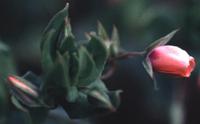
Pimpernel is an herb of protection and consecration. Some wear this herb to keep people from deceiving them. Its a good herb to hang in one's home to protect it from negative energy. It is said this herb assists with second sight. This is an excellent herb for consecration of athames and other ritual blades. Pimpernel may be added to amulets to be carried or worn by those traveling. It is said to protect the wearer from all manner of mishaps during a vacation or journey. Pimpernel is a healing herb that is good for depression.
Medicinal and Other Uses:
Pimpernel is a mild sedative, anti-depressant, and diuretic. An infusion made of the entire plant is said to help mental disorder, and is used in the prevention of pulmonary consumption. A tincture is said to be good for relieving irritations of the urinary tract. **GT** This plant is toxic to cats, so please keep that in mind if you own a feline familiar.
Pine-
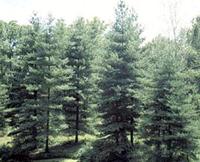
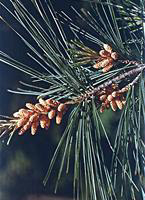
Pine (Pinaceae Species, also known as Longleaf Pine, Shortleaf Pine, Yellow Pine, Georgia Pine, Southern Pine, the list is huge..) is one of our most taken for granted, majestic trees. I will never forget stopping at a rest stop on the Georgia interstate on my way to my getaway place. A bus load of Japanese tourists were staring up at the sky in amazement and pointing excitedly at something. I couldn't, for the life of me, figure out what they were so in awe of? I walked over and asked the tour bus driver, and he said, "that there Pine Tree little missy". It suddenly hit me that these people had probably never seen something we see everyday, a southern Pine standing over 150 feet tall straight up. We have an old saying here in the South: "Higher than a Georgia Pine". (After I thought about it, the trees in Japan are very short and windswept) From that moment on, I never took any of our natural resources for granted. Pinus Lambertiana, the Sugar Pine, can reach heights of around 250 feet. The current national champion, (near Dorrington, CA.) is 232 feet tall and is the world's largest Pine tree. "Pinus" is the Latin for Pine. Pinaceae are known in the fossil record since the Cretaceous period. Many folks don't realize the Pine is a gymnosperm and has "dual cones". The male Pine has a cone that releases pollen which floats over to the female Pine cone to fertilize it. Those large cones folks associate with the Pine are actually the female cones. Male cones are usually as small as your finger and soft. (see the photos in this section) Pine is also a very ancient tree. Pinus Longaeva, the Great Basin or Intermountain Bristlecone Pine, (in the White Mountains near Bishop, CA.) has individuals up to 4900 years old. Sort of puts things in perspective, doesn't it?
Magickal Uses:
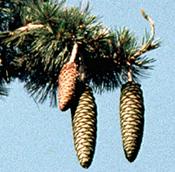
Pine is an herb of protection, countermagick, and purification. Its invocatory can be Cybele, Poseidon, or Rhea. Pine needles may be dried and ground to be used as incense. The wood can be powdered or the resin dried and added to Magickal workings. Pine has the ability to cleanse a space of negative energy, and send dark forces back to their source. The cones may be carried as fertility charms, and the nuts eaten for the same purpose. Add the crushed needles to your bath for a cleansing bath. Pine has a history giving it an affinity for today's male priesthoods. It lends itself to male sexual energy which has been removed from the procreative purpose. This sacred tree is ideal for those men seeking to bring their sexual drive under control and channel it toward sacred goals.
Medicinal and Other Uses:
The whitish new shoot at the tip of a Pine branch can be boiled into a tea that can be used as a substitute for coffee. Pine can also be used as a remedy for colds. The green needles of the Pine tops can be boiled as a tea and taken to relieve menstrual cramping. Old, but still green, needles can be boiled with Pine gum and taken as a remedy for severe colds and fevers. Pine has a wide multitude of usage as aromatherapy essential oil, turpentine, saw timber, pulp wood, pine nuts, Yule trees, craft cones, rosin, pitch, landscape trees, mulch, seeds for wildlife food, shelter-belt trees, and for revegetation and on & on.
Plantain-


Plantain (Plantago Major, also called Broadleaf Plantain, Weybroed, Ripple Grass, Waybread, Slan-lus, Waybroad, Snakeweed, Cuckoo's Bread, Englishman's Foot, and White Man's Foot) is considered an invasive weed in many locations. The Saxons considered it one of their nine sacred herbes. Shakespeare referred to Plantain in many of his works. In "Schoolmistress" he wrote: "And plantain rubb'd that heals the reaper's wound". In olden times Plantain was considered a powerful healing herb, and was called the "mother of herbs". Native Americans have used Plantain as a medicinal healing herb since before the time the white man invaded America. (The leaves of Plantago contain tannin and thus are astringent, or able to draw tissues together)
Magickal Uses:
Plantain is ruled by Venus. This common weed was once a highly regarded Magickal herbe. Grieve mentions it in "A Modern Herbal" by stating, "Our Saxon ancestors esteemed it highly and in the old Lacnunga the Weybroed is mentioned as one of nine sacred herbs. In this most ancient source of Anglo-Saxon medicine, we find this salve for flying venom". Plantain may be used to enhance the power of any Magickal working.
Medicinal and Other Uses:
Plantain is an anti-toxic, anti-inflammatory and expectorant. These characteristics suggest why the plant is useful in lung disorders, and as inferences as to the effect of the Plantago Major on smokers. It is a confirmed antimicrobial and it is said to stimulate the healing process. Its astringent properties are said to stop bleeding. Its also used for asthma, bed-wetting, bronchitis, bruise, chronic skin disorders, cough, cystitis, dermatitis, diarrhea, dysuria, hematuria, hemorrhoids, inflammation, insect bites, Bee Stings, scrofula, sores, sore throat, stomatitis, syphilis, upper respiratory catarrh, urinary tract infection, and wounds. **WC** Warning: Some Plantains may cause dermatitis.
Pomegranate-


Pomegranate (Punica Granatum, also called Apple of Carthage) has traditionally been considered a symbol of beauty and fertility. One story involves Persephone, daughter of Ceres, and Goddess of growth and abundance. While wandering in the beautiful gardens of Hades she was unable to resist eating seeds of the Pomegranate. She was forced to become the wife of Hades, and she became a goddess of the Underworld. The Greeks considered the Pomegranate to be a symbol of feminine fertility. Although associated with women's mysteries, the Greeks believed the Pomegranate originated from the blood of Dionysus, who was slain by the order of Juno. The word "Pomegranate" is derived from Middle French "pome" and "garnete" and which means "seeded apple." The San Joaquin Valley in California is the only concentration of commercially grown pomegranates in America. Some believe the Pomegranate and not the Apple to be the fateful fruit Eve plucked from the tree....Eve Was Framed......
Magickal Uses:
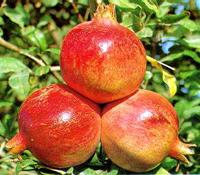
Pomegranate's invoactory may be Adonis, Aphrodite, Hera, Kishimo-jin, Persephone, or Saturn. Pomegranate has a magickal history derived from both early Herbrew and pagan origins. It was sacred to Solomon and to Rimmon (a name for Adonis). Once considered the only fruit sacred enough to gain admission into the holy of holies, it was embroidered upon the high priest's sacred robe. This red fruit has long been considered a key to creation. Given as a gift Pomegranate may bestow abundance and wishes for the fertility of the creative spark. It is brought into ritual, eaten as part of the feast as the participants contemplate some of the deeper, more profound mysteries. Pomegranate may be used to decorate the temple. The juice may be used to fill the ritual cup, whether one is moving with the Goddess into the Underworld, or seeking to learn from the lessons of Saturn.
Medicinal and Other Uses:
One Pomegranate provides most of the body's daily Potassium needs, and Pomegranate contains Vitamin C and Iron. Pomegranate juice is used in preparations for treating dyspepsia and is considered beneficial in leprosy. Recent studies are finding the extracts of Pomegranate may prove to be a viable alternative or adjunct to conventional treatments for viral infections, cancer and liver damage. The bark of the stem and root are used to treat tapeworm problems. Because of their tannin content, extracts of the bark, leaves, immature fruit and fruit rind have been given as astringents to halt diarrhea, dysentery and hemorrhages. Dried, pulverized flower buds are employed as a remedy for bronchitis. In Mexico, a decoction of the flowers is gargled to relieve oral and throat inflammation. Leaves, seeds, roots and bark have displayed hypotensive, antispasmodic and anthelmintic activity. Grenadine is a light Pomegranate syrup used as a flavoring in alcoholic drinks, soft drinks, and confections. All parts of the tree have been utilized as sources of tannin for curing leather. Both the rind and the flowers yield dyes for textiles. **GT** Pomegranate is an attractive source of food for hummingbirds when in bloom.
Poplar-


Poplar (Pupulus Species, also known as Black Poplar, White Poplar, Yellow Poplar and Tulip Poplar) trees have been known to reach 190 feet in height. By far the tallest species in the eastern forests, their limbs are covered with huge, tulip-shaped, yellow flowers every Spring. Imagine coming across one on a quiet walk in the woods. Nearly 200 feet tall, covered with "tulips." The 1992 National Register of Big Trees identifies today's largest yellow Poplar. It is found in Bedford, Virginia and is 146 feet tall with a canopy of 125 feet spread and a trunk circumference of 374 inches. East Coast Native American populations made long dugout canoes carved from the trunks of the tall yellow Poplar. Researchers plan to clone a 400-year old tulip Poplar (located on St. Johns' College campus in Annapolis, MD). This Poplar, which many historians view as more important to our history than the eagle, represents the last of 13 "Liberty Trees" where patriots meet in the 1700s to protest British rule. I have several of these giants growing up out of a ravine on my property in Georgia. When they are in bloom, the entire woods smell like bananas. Poplar is the state tree of Indiana, Tennessee, and Kentucky. Poplar is found in many myths, in one, Leuce, a lovely young nymph, catches the eye of Hades. Hades fell in love with Leuce, and after she died he transformed her into a white Poplar to keep her memory sacred.
Magickal Uses:
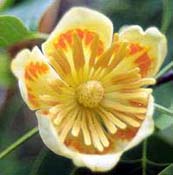
Poplar is ruled by Saturn. Its invocatory can be Dryope, Hercules, Leuce, and Paethon. Poplar buds are fairly resinous and can be dried and used in incense. The flowers of the Tulip Poplar may be used to adorn the temple or altar. An oil of Poplar may be used to anoint someone when they are honored for their good works. Turn to this tree for the strength needed to transcend the human condition and reach beyond our limitations. Some use Poplar in their flying mixtures. Poplar may be added to working involving Money charms or spells.
Medicinal and Other Uses:
Black Poplar is well supplied with salicin, a substance closely related to the active agent in modern aspirin. Its buds, bark and the leaves have been used since antiquity in preparations for coughs, asthma, rheumatism and inflammations of all kinds. The buds are used in salves for burns, boils and in liniments for rheumatic pains, and internally for the relief of pain as well as heart trouble. (The Wood produces a bitter alkaloid chemical called "tulipferene" which is a heart stimulant) Poplar is used to make toys, broom handles, boxes, crates, baskets, food containers, popsicle sticks and tongue depressors. Before they were made of metal and plastic, Venetian blinds were made of Poplar. Poplar is used as the interior components of fine furniture and cabinetry. Recently Poplar has been used in the manufacture of plywood. **GT** Poplars have a massive shallow, and invasive root system. The roots can become such a problem that the Carolina Poplar, (Populus canadensis) is now even prohibited by law in some areas. All Poplar species must be planted with caution. They should never be planted near paving or drains because of the invasive tendencies of the roots. The new little trees which sprout up are sucker growths coming out of the roots. Songbirds, rabbits, squirrels and mice feed on the seeds. Whitetail deer browse the young growth.
Poppy-


